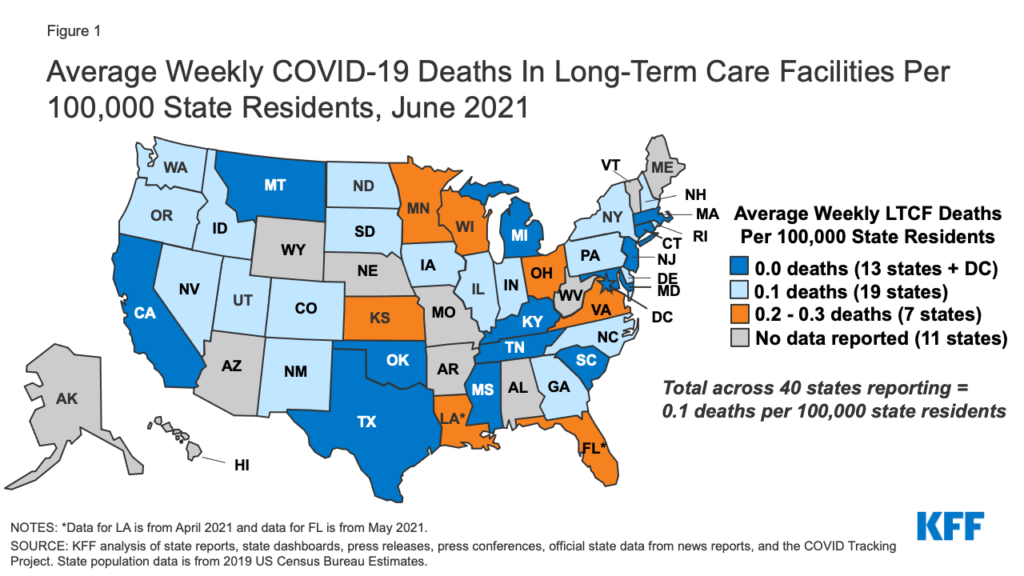
The coronavirus crisis in U.S. nursing homes is being prevented from coming to a close due to the rise of the delta variant and low vaccination rates both inside and outside of long-term care facilities, according to new research from the Kaiser Family Foundation.
“These factors will be important to consider as policymakers use the experience of the pandemic in these settings to inform policy moving forward,” KFF investigators Priya Chidambaram and Rachel Garfield stressed Monday.
The new KFF data analysis of COVID-19 cases and deaths in long-term care facilities found that deaths in the facilities had fallen significantly through the end of June (the most recent month full data was available). Federal data showed that the country’s seven-day case average reached about 63,250 new cases per day as of Sunday.
Fourteen states reported zero or close to zero weekly deaths per 100,000 in June. Twenty-one additional states reported all-time low COVID death rates.
The overall average weekly number of COVID-19 deaths in long-term care facilities per 100,000 state residents was 0.1 in June, which is a 96% decline from December when the figure was 1.6 per 100,000, researchers said.

Just five states (Colorado, Georgia, New York and Wisconsin) reported an increase in COVID-19 deaths in long-term care facilities as of June 30 when compared to earlier periods during the crisis, according to study authors. Researchers noted that across all five states the long-term care deaths in the most recent month were still “substantially lower” than at their peaks.
When it comes to COVID-19 cases counts, Chidambaram and Garfield found that average new weekly cases in long-term care were just 0.5 per 100,000 in June. That’s compared to a peak of 19.7 in December, which is a 97% decrease.
Unvaccinated staff suspected
One state (Rhode Island) reported zero cases per 100,000, while 12 states reported higher average weekly cases in June when compared to earlier months.
“Among the 12 states that report data on new cases among residents and staff separately, most states reported higher new cases among LTCF staff than LTCF residents, likely reflecting the higher share of unvaccinated staff in LTCFs when compared to LTCF residents,” the authors explained.
Chidambaram and Garfield explained it’s unknown whether the new cases are among vaccinated or unvaccinated residents and staff, or whether these cases came from delta variant infections. However, they added the trends facilities are seeing with declining case and death counts could be negatively impacted due to the “highly transmissible nature of the delta variant.”
“Additional weeks of data are necessary to understand whether this slight uptick is due to a data anomaly or the rise of the Delta variant in surrounding communities,” the two wrote.
“Ongoing tracking and analysis can shed light on the impact of increased community cases, given the close ties between community spread and LTCF cases and deaths,” they added.
Their analysis quantified how within weeks of the first vaccine doses being administered, nursing home cases and deaths plummeted while all other cases and deaths increased.
Researchers also praised the effect the news media had in some places. While federal authorities were slow to start publishing weekly nursing home cases and deaths, making state-to-state comparisons impossible, local, regional and national media outlets started analyzing data on their own.
That led, for example, to a local Wisconsin news outlet pointing out that a data correction, not actual events on the ground, had changed COVID numbers in the area.
“This pattern repeated throughout the pandemic: Many states had a few dedicated reporters and news outlets who kept a close eye on their individual state’s long-term care data and, importantly, had contacts in the right state departments,” Kaiser researchers wrote. “These local news outlets were instrumental in providing insight into data anomalies or state changes that affected data reporting, and effectively created an additional network of data experts for researchers to leverage.”





